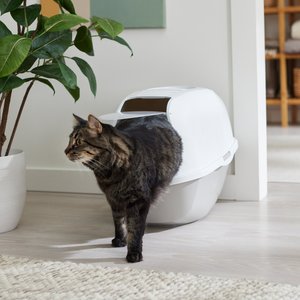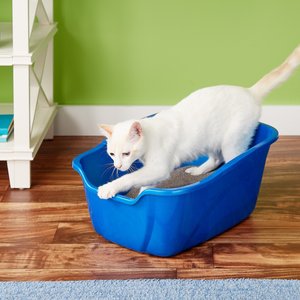How to train an adult cat to use a litter box they don’t like
Cats are generally known to be fastidious creatures that are clean and well-groomed. They instinctively use a litter box to relieve themselves, making it easier for their owners to maintain a clean living space. However, there may be instances when your adult cat refuses to use a litter box they don’t like, making it a frustrating situation for pet owners. In this article, we’ll go through some tips and tricks to train an adult cat to use a litter box they don’t like.
Understanding the Reason for Avoidance
The first step in training a cat to use a litter box they don’t like is to identify the reason why they are avoiding it. There can be a few reasons why a cat may refuse to use the litter box, such as:
- Health issues: Your cat may be suffering from a urinary tract infection or another health issue that causes discomfort while using the litter box.
- Litter box issues: The litter box may not be the right size for your cat, or it may not be cleaned frequently enough.
- Environmental changes: If there have been changes in the household or the cat’s living environment, such as a new pet or a new home, your cat may be stressed and may refuse to use the litter box.
- Preference: Some cats may have a preference for certain types of litter or litter boxes.
Once you have identified the reason for the cat’s avoidance, you can take steps to address the issue.
Addressing Health Issues
If you suspect that your cat is avoiding the litter box due to health issues, you should take them to a veterinarian for a checkup. Your vet can diagnose and treat any health issues your cat may be experiencing, which can help to alleviate any discomfort your cat may be feeling while using the litter box.
Adjusting Litter Box Placement
 If your cat is avoiding the litter box due to its placement, you can try relocating the box to a more suitable area. Litter boxes should be placed in a quiet, private area where your cat can use it without interruption. Avoid placing the litter box near food or water, as cats prefer to keep their eating and elimination areas separate.
If your cat is avoiding the litter box due to its placement, you can try relocating the box to a more suitable area. Litter boxes should be placed in a quiet, private area where your cat can use it without interruption. Avoid placing the litter box near food or water, as cats prefer to keep their eating and elimination areas separate.
Choosing the Right Litter Box
The size of the litter box is essential to consider when training your cat to use it. A litter box that is too small for your cat may be uncomfortable, while a litter box that is too large may be difficult for your cat to access. The general rule of thumb is that the litter box should be one and a half times the length of your cat, from nose to the base of their tail.
Want to know more about litter boxes click here
If your cat is avoiding the litter box due to its size, consider investing in a new one that is more suitable for their needs. You can also try different types of litter boxes, such as ones with high sides or lids, to see if your cat has a preference.

Choosing the Right Type of Litter
Cats have different preferences when it comes to litter, so it may take some trial and error to find the right type that your cat likes. There are several types of litter available, such as clay, clumping, and silica gel litter. You can try different types of litter to see which one your cat prefers.
Introducing a New Litter Box
If your cat has developed a preference for a particular type of litter box, such as an open-top or covered litter box, it may take some time to train them to use a new one. You can introduce the new litter box gradually by placing it next to the old one and gradually moving it to a new location.
If your cat is avoiding the litter box due to its newness, you can try placing some of their old litter in the new box to help them adjust. You can also try placing treats or toys near the new litter box to make it more appealing and encourage your cat to investigate it.
Using Positive Reinforcement
 Positive reinforcement is an effective way to train your cat to use a litter box they don’t like. You can reward your cat with treats or praise every time they use the litter box correctly. This positive reinforcement can encourage your cat to continue using the litter box, making it a positive experience for them.
Positive reinforcement is an effective way to train your cat to use a litter box they don’t like. You can reward your cat with treats or praise every time they use the litter box correctly. This positive reinforcement can encourage your cat to continue using the litter box, making it a positive experience for them.
Punishing your cat for not using the litter box is not recommended as it can cause stress and anxiety, leading to further litter box avoidance.
Maintaining a Clean Litter Box
Cats are clean animals and prefer to use a clean litter box. If the litter box is dirty or has a strong odor, your cat may avoid using it. It’s important to clean the litter box regularly, at least once a day, and replace the litter every week.
If you have multiple cats, you should have one litter box per cat, plus one extra. This can reduce the competition for the litter box and make it easier for each cat to find a clean litter box.

Conclusion
Training an adult cat to use a litter box they don’t like can be a frustrating experience, but with patience and persistence, it can be done. It’s important to identify the reason for the litter box avoidance and address the issue accordingly. This can involve adjusting the litter box placement, choosing the right litter box and litter, and using positive reinforcement.
Maintaining a clean litter box is essential to ensure that your cat continues to use it. If you’re having trouble training your cat to use the litter box, consider consulting with a veterinarian or a professional animal behaviorist. With the right training and care, your cat can learn to use the litter box they don’t like, making it easier for you to maintain a clean and healthy living environment.
This content may contain links to products, software and services. Please assume all such links are affiliate links which may result in my earning commissions and fees.

Leave a Reply